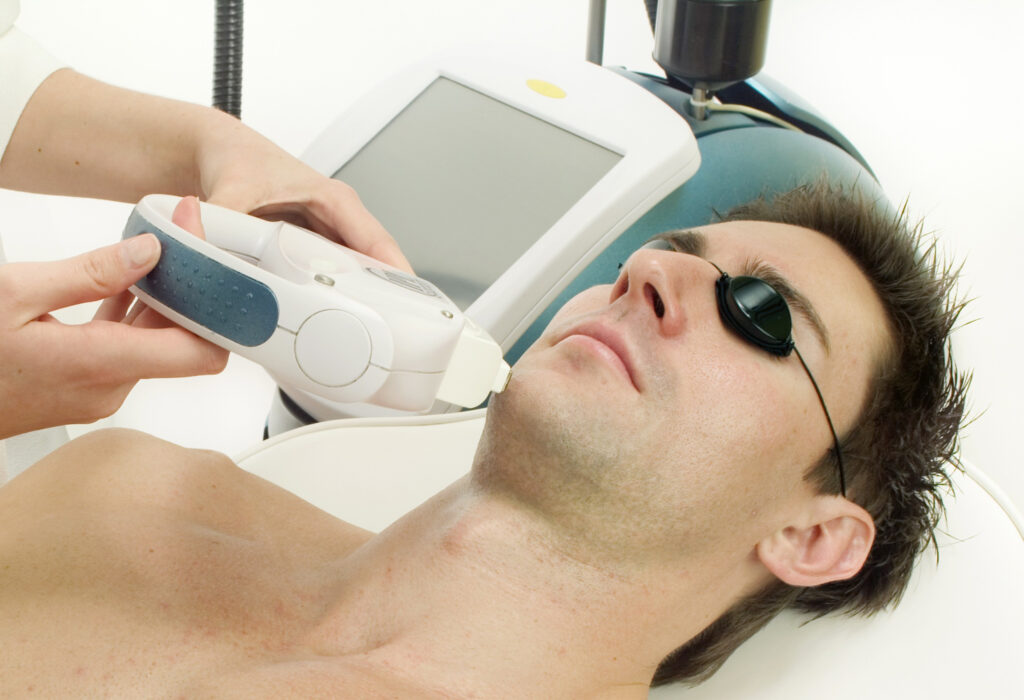How does it work?
IPL systems work on the same principles as lasers in that light energy is absorbed into particular target cells with colour (chromophores) in the skin. The light energy is converted to heat energy, which causes damage to the specific target area. IPL systems are different to lasers in that they deliver many wavelengths (or colours) in each pulse of light instead of just one wavelength. Most IPL systems use filters to refine the energy output for the treatment of certain areas. This enhances penetration without using excessive energy levels and enables targetting of specific chromophores (these are skin components that absorb light).
IPL therapy is considered a non-ablative resurfacing technique, which means that it targets the lower layers of skin (dermis) without affecting the top layers of skin (epidermis). The results are not as dramatic as ablative resurfacing where both the dermis and epidermis are injured to produce a much more noticeable overall outcome. The advantage of IPL therapy is its minimal downtime – a patient can often have the procedure done in their lunch break and return to work immediately afterwards.
You can use IPL to minimize or remove:
- age spots
- sun damage
- freckles
- birthmarks
- varicose veins
- broken blood vessels on your face
- rosacea
- hair on your face, neck, back, chest, legs, underarms, or bikini line
The difference between IPL and laser treatment
IPL is similar to a laser treatment. However, a laser focuses just one wavelength of light at your skin, while IPL releases light of many different wavelengths, like a photo flash.
The light from IPL is more scattered and less focused than a laser. IPL penetrates down to the second layer of your skin (dermis) without harming the top layer (epidermis), so it causes less damage to your skin.
Pigment cells in your skin absorb the light energy, which is converted into heat. The heat destroys the unwanted pigment to clear up freckles and other spots. Or, it destroys the hair follicle to prevent the hair from growing again.
You can use IPL anywhere on your body, but it may not work as well on uneven areas. It isn’t recommended for people who tend to get thick, raised keloid scars or who have darker skin tones. It’s also not as effective on light-colored hair as it is on darker hair.
How to prepare
Before your IPL procedure, your skin care specialist will examine your skin and let you know what to expect. Let them know if you have any skin conditions that might affect healing after your treatment, such as inflammatory acne or eczema.
Your skin care specialist may recommend that you avoid certain activities, medications, and other products for two weeks prior your procedure.
You should avoid:
- direct sunlight
- tanning beds
- waxing
- chemical peels
- collagen injections
- drugs that increase your bleeding risk, such as aspirin (Ecotrin) and ibuprofen (Advil)
- creams or other products that contain vitamin A, such as RetinA, or glycolic acid
What to expect during the procedure
Your skin care specialist first cleans the area that’s being treated. Then they rub a cool gel onto your skin. Then, they apply light pulses from the IPL device to your skin. During your treatment, you’ll need to wear dark glasses to protect your eyes.
The pulses might sting your skin. Some people liken the feeling to being snapped with a rubber band.
Depending on which part of your body is being treated and how large the area is, the treatment should take 20 to 30 minutes.
To get the results you want, you may need to have three to six treatments. Those treatments should be spaced about one month apart to let your skin heal in between. Hair removal requires 6 to 12 treatments.
How well it works
Newer IPL devices work about as well as laser treatments for some cosmetic treatments, such as fading blood vessels in the skin. For hair removal, IPL works better on thick, dark hair than on fine, light hair. You may need to have several treatments to achieve your desired result.
Possible risks
Most people experience mild redness or swelling after the procedure. This typically fades within a day or two.
In some cases, you may experience:
- bruising
- blistering
- change in skin color
What to expect afterward
You should be able to go right back to your regular activities. The treated area of skin will be red and sensitive for a few hours, as if you got sunburned. Your skin may be slightly swollen, too. Your skin will continue to be sensitive for a couple of days after the procedure. You may need to avoid using hot water on it until your skin heals.





 Bahrain
Bahrain
Hi, this is a comment.
To get started with moderating, editing, and deleting comments, please visit the Comments screen in the dashboard.
Commenter avatars come from Gravatar.